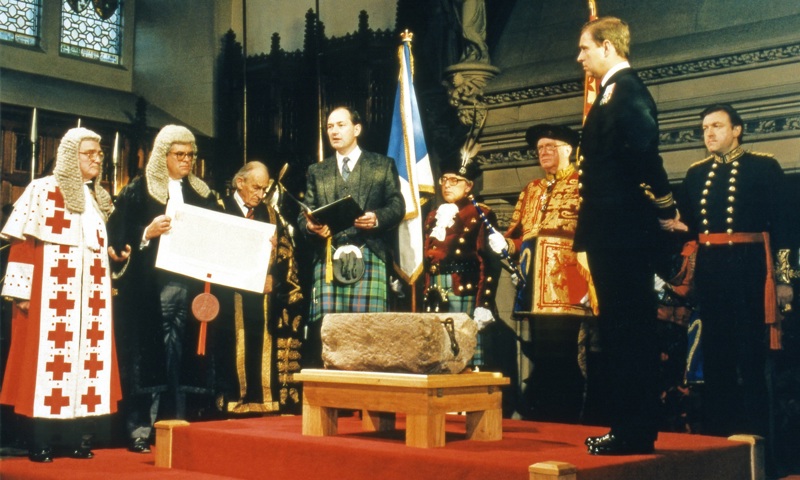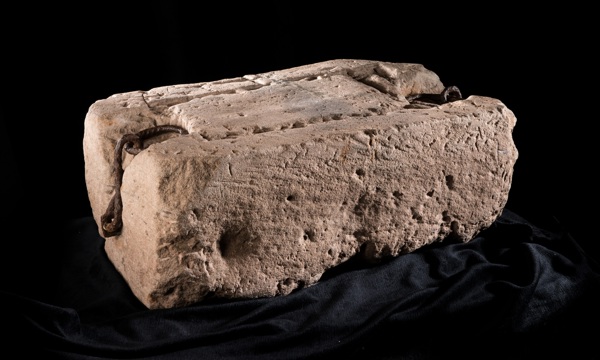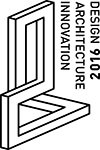The centuries old Stone of Destiny was winched out of the Coronation chair inch by inch – a careful operation that took collections and conservation specialists a significant amount of time to complete. This information is among 20 facts to be released by Historic Environment Scotland (HES) to mark the 20th anniversary of the Stone of Destiny’s return to Scotland in the 1990s.
On St Andrews Day 1996 the Stone of Destiny completed a 400 mile, police escorted journey from Westminster Abbey to Edinburgh Castle. This was the culmination of months’ worth of highly detailed planning, following on from an announcement in Parliament on 3rd July 1996 by the then Prime Minister John Major.

On St Andrews Day 1996, the Stone of Destiny returned to Scotland.
Other facts reveal that a Glasgow pub was suggested as one of the more unusual long-term locations for the Stone, as proposed by a member of the public during the consultation process. The transportation of the Stone within the Abbey called for a specially designed hand barrow, which was based on the type used by medieval stonemasons. It was measured and built to specifications that would allow two men to carry the 152kg Stone by hand over the narrow footbridge leading from St Edward the Confessor’s Chapel.
Specialist conservation works following the Stone’s return, carried out before it was publicly displayed, uncovered a hidden message, dating from the 1970s. Cleaning of the 700 year old, red sandstone object found a wax seal and a small lead tube containing a triangle of paper; it was later discovered to be an offcut from an official authentication document, which had been inserted into the side of the Stone. It is thought to have been done as a measure to prove the Stone’s authenticity if it was ever taken.
Among those involved in the Stone of Destiny’s return operation, 20 years ago, was Richard Welander, then Head of Collections at Historic Environment Scotland. Richard along with six other members of staff formed a core task group. He also held a hands-on role at Westminster Abbey during the Stone’s removal in November 1996. He said:
The Stone of Destiny is truly unique. There is no other object quite like it that continues to captivate and intrigue audiences in equal measure – even twenty years on since its return."
“Now helping to mark this anniversary, these lesser known facts offer an insight into the Stone of Destiny, its history and significance, whilst newly released information helps shed a light on some of the behind the scenes processes which were involved in its return in 1996.”
The Stone of Destiny forms part of the Honours of Scotland Exhibition at Edinburgh Castle. St Andrews Day – Wednesday 30th November, 2016 – is the 20th anniversary of the Stone’s return to Scotland.
20 facts for 20 years:
- The idea to return the Stone of Destiny to Scotland was first suggested by Michael Forsyth’s young daughter. Lord Forsyth was the Secretary of State for Scotland in 1996.
- During the public consultation over the summer of 1996, a Glasgow pub was one of the more unusual proposals for the long-term location of the Stone on its return to Scotland.
- The whole operation was conducted with great respect and discretion. From the announcement in Parliament on 3rd July 1996 by the then Prime Minister, John Major, of the Stone’s intended return to Scotland to its public display in Edinburgh Castle on St Andrews Day that year, detailed arrangements were known to very few.
- The van driven down from Edinburgh to collect the Stone wasn't empty. It actually contained the St Andrews Sarcophagus – an early 9th century Pictish masterpiece from St Andrews Cathedral. It was leaving Scotland for the first time since its discovery in 1833 to be loaned to the British Museum as the centrepiece of the ‘Heirs of Rome’ exhibition.
- The Historic Environment Scotland team – then Historic Scotland – were met by police officers at Kings Cross station on the afternoon of Wednesday 13th November and transported through London to the Hendon Police College. From there the team was taken to central London after Westminster Abbey had closed to visitors for the night. Five of the original team of seven are still members of staff at Historic Environment Scotland.
- A specially-designed scaffold had to be carried into the Abbey and carefully erected over the Coronation Chair. A running pulley was mounted above and a block and tackle used to winch the Stone up and out of the Chair inch by inch then slid forward and lowered onto a purpose built hand barrow. This procedure had been rehearsed many times over the summer at Edinburgh Castle, even ensuring the equipment could take the weight of the stone.
- The slow and carefully planned operation of lifting the Stone out of the Coronation Chair took a significant amount of time, with collection and conservation specialists working into the early hours.
- The specialist team were escorted and under guard by armed police throughout the operation.
- A wooden hand barrow, based on those used by medieval stonemasons, which had been specially designed and made to carry the Stone out of the confines of St Edward the Confessor’s Chapel over a narrow footbridge. The Stone, which weighs 152kg, was then taken to the nave to wait overnight until being carried out of the Abbey’s West Door early the following morning to waiting vehicles and the start of its journey north, under police escort.
- On its return to Scotland, the Stone was prepared for its public appearance at Edinburgh Castle on St Andrews Day 1996. At this time the Stone was closely studied and recorded for the first time in its long history.
- The Stone was covered in decades of accumulated dust and debris, and was gently cleaned using steam to reveal the surface details; including an extraordinary array of tool marks and incisions that still remain difficult to understand and interpret today.
- Famously in the early hours of Christmas Day 1950 three Glasgow students broke into Westminster Abbey and, using a mackintosh to drag it over the tiled floor, removed the Stone. In attempting to lift the Stone out of the Coronation Chair, it fell and a corner was broken off. The students escaped back to Scotland and the Stone remained hidden for several weeks during which time it was repaired in Glasgow before being deposited on 11th April 1951 at Arbroath Abbey, the signing place of the Declaration of Arbroath in 1320.
- In the late 1970s there was another attempt by a Glasgow student to take the Stone. It was unsuccessfully and little-reported but the Abbey’s then Surveyor of the Fabric was sufficiently concerned about how to prove authenticity if the Stone was ever taken that he arranged for a small lead tube containing a triangle of paper, an offcut from an official authentication document, to be inserted into the side of the Stone and sealed with sealing wax. This was discovered during cleaning and conservation work in Edinburgh.
- The Stone was privately exhibited in the Palace of Holyroodhouse the evening before St Andrews Day 1996, before being taken to the Great Hall in Edinburgh Castle where Prince Andrew, representing HM The Queen, formally issued the Royal Warrant to the Commissioners of the Regalia transferring the Stone into their safekeeping.
- Under the conditions of the Royal Warrant, the Commissioners are responsible for ensuring that the Stone returns to Westminster Abbey for the next and all future coronations of monarchs of Great Britain.
- Around 10,000 people lined the Royal Mile to catch a glimpse of the Stone of Destiny as it made its way to Edinburgh Castle from the Palace of Holyroodhouse on 30th November 1996.
- Two years after the Stone’s return to Scotland, permission was given for British Geological Survey staff to conduct a technical examination of the Stone. The survey team carried out the works locked inside the Crown Room of Edinburgh Castle. The geological results were conclusive and showed that the stone is a sandstone of the Scone Sandstone Formation, likely quarried close to Scone. Geologically, the stone is of Early Devonian age, around 400 million years old.
- The most frequently asked question – “Is it the real thing?” The consistent answer over the past 20 years is: Yes. It's the Stone taken away from Scone Abbey by Edward I of England in 1296.
- Every English – and, after 1707 and the Act of Union, British – monarch since 1296 has sat on the Stone for their Coronation. The Coronation Chair was made especially for the Stone by Walter of Durham between 1297 and 1300. It has recently been re-displayed to the public by the Dean and Chapter in a chapel near the west entrance to the Abbey.
- In June 1914 Suffragettes targeted the Stone and Coronation Chair to protest on behalf of women's rights. They exploded a bomb that damaged the top of the Chair. It’s been speculated that the blast might have caused a crack in the Stone that only became apparent on Christmas Day 1950 when Glasgow students removed the Stone away back to Scotland.
About Historic Environment Scotland (HES)
- We are the lead public body charged with caring for, protecting and promoting the historic environment. We will lead on delivering Scotland’s first strategy for the historic environment, Our Place in Time.
- Historic Scotland is a sub brand of HES.
- View our press pack and keep up to date by registering for media release email alerts. If you wish to unsubscribe, please contact us.
Year of Innovation, Architecture and Design 2016
2016 is the Year of Innovation, Architecture and Design (IAD). Through a series of exciting events and activity, the year will showcase Scotland's position as an "innovation nation", its outstanding built heritage, and its thriving, internationally acclaimed creative industries sector. This is a Scottish Government initiative being led by VisitScotland and supported by a variety of partners.
Follow Historic Environment Scotland
Twitter: @HistEnvScot | @welovehistory
Facebook: @HistoricEnvScotland | @VisitHistoricScotland
For further information, please contact:
Grant Thomson
Historic Environment Scotland Media Office
Direct Line: 0131 668 8603
Mobile: 07580 702 611
grant.thomson@hes.scot


